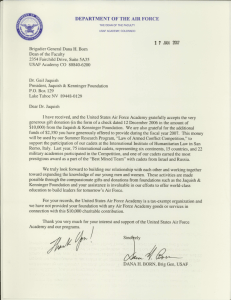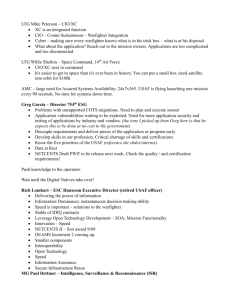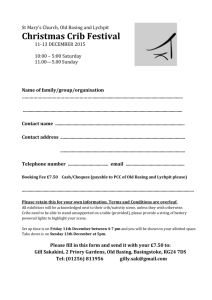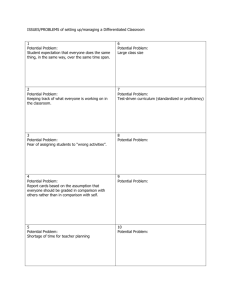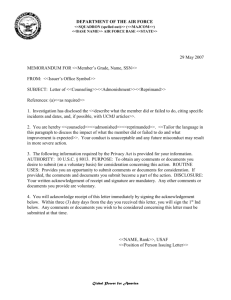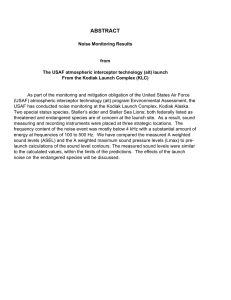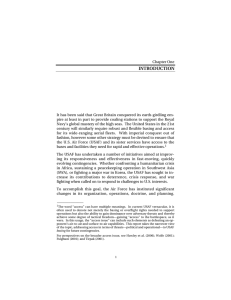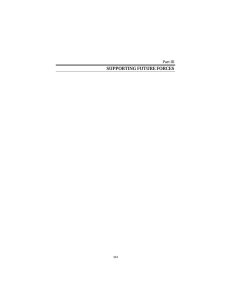SUMMARY
advertisement
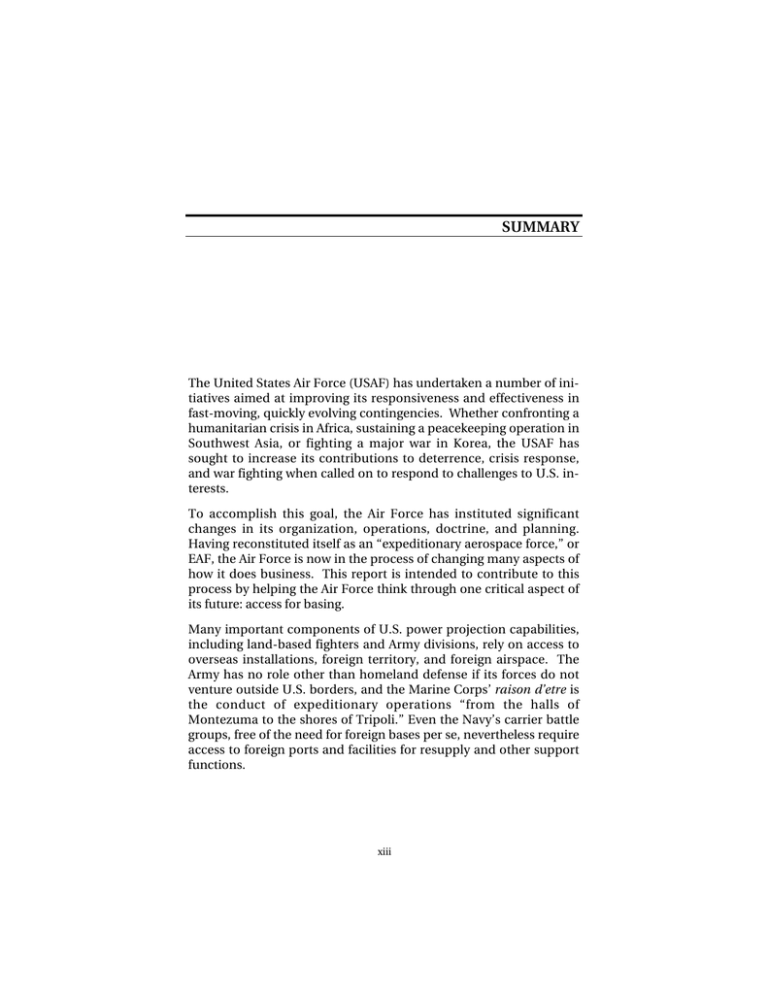
SUMMARY The United States Air Force (USAF) has undertaken a number of initiatives aimed at improving its responsiveness and effectiveness in fast-moving, quickly evolving contingencies. Whether confronting a humanitarian crisis in Africa, sustaining a peacekeeping operation in Southwest Asia, or fighting a major war in Korea, the USAF has sought to increase its contributions to deterrence, crisis response, and war fighting when called on to respond to challenges to U.S. interests. To accomplish this goal, the Air Force has instituted significant changes in its organization, operations, doctrine, and planning. Having reconstituted itself as an “expeditionary aerospace force,” or EAF, the Air Force is now in the process of changing many aspects of how it does business. This report is intended to contribute to this process by helping the Air Force think through one critical aspect of its future: access for basing. Many important components of U.S. power projection capabilities, including land-based fighters and Army divisions, rely on access to overseas installations, foreign territory, and foreign airspace. The Army has no role other than homeland defense if its forces do not venture outside U.S. borders, and the Marine Corps’ raison d’etre is the conduct of expeditionary operations “from the halls of Montezuma to the shores of Tripoli.” Even the Navy’s carrier battle groups, free of the need for foreign bases per se, nevertheless require access to foreign ports and facilities for resupply and other support functions. xiii xiv A Global Access Strategy for the United States Air Force Similarly, access and basing issues are of great importance to the USAF. Like the Army, USAF forces are for the most part equipped and configured to fight from “in theater”; fighters and attack aircraft such as the A-10, F-15, F-16, and F-117 have unrefueled combat radii of 300–500 nm. And while these ranges can be greatly extended through aerial refueling, such aircraft cannot be used to best advantage when they are based thousands of miles from their intended targets.1 Moreover, Air Force operations have experienced real difficulties because of access problems, most recently during a series of post–Desert Storm crises in the Gulf from 1996 to 1998. Earlier, the emergency airlift to Israel during the 1973 Middle East war and the 1986 El Dorado Canyon punitive strike on Libya were similarly hampered by access difficulties. For a variety of reasons, these issues are not expected to disappear in the coming years: • First, despite many predictions that the nation-state will become increasingly irrelevant, we see no evidence that governments are losing control of their physical territory.2 • Second, the kinds of contingencies that crop up in the next decade or two will likely occur in areas where the United States faces sizable access uncertainties. • Finally, compounding the problem is the fact that evolving threats may induce planners to consider basing air forces farther away from enemy territory. The USAF thus faces a complicated set of demands as it confronts its future as an expeditionary force. It must plan, organize, equip, and train itself according to a new set of principles suited to a world that ______________ 1Chapter Three includes a detailed analysis of the reasonable limits of extended-range operations for most current USAF fighters and attack aircraft. We also note that the next planned generation of USAF tactical aircraft, the F-22 and the F-35 Joint Strike Fighter (JSF), do not feature increased range among the advantages they will have over existing platforms. 2There are several examples of failed or weak states such as Somalia whose central control of their territory is uncertain at best. However, even in these cases, someone— a local warlord perhaps, or rebel faction—exerts de facto authority over the real estate in question, and U.S. military operations in, from, or above that territory must take into account the desires of the controlling authority, whether legitimate or not. Summary xv demands frequent, short-notice deployment and employment across a spectrum of conflict that may occur virtually anywhere in the world. Moreover, the Air Force must do so in the face of grave uncertainties—driven by ineluctable political and military realities— regarding where, how, and when it will be able to operate. The USAF therefore needs a global access and basing strategy that will help it prepare for tomorrow’s requirements. This report outlines an approach to such a strategy and recommends some specific components thereof. THE POLITICS OF ACCESS Understanding how circumstances have affected other countries’ past decisions about U.S. access can help the Air Force better prepare for contingencies to come. We reviewed the history of U.S. access around the world, region by region, to draw out lessons that might help planners and others lay a firmer groundwork for ensuring adequate future access. This analysis led us to a set of implications for the Air Force. First, we identified six factors that seem to have a profound effect on other countries’ decisions regarding whether to cooperate with the United States in a given situation. Three factors that seem to favor cooperation are • Close alignment and sustained military connections, • Shared interests and objectives, and • Hopes for closer ties with the United States. Three factors that appear to work against cooperation are • Fear of reprisals, • Conflicting goals and interests, and • Domestic public opinion. Our global survey suggests that two fundamental tools available to the United States are particularly appropriate to helping ensure access. The first such tool—transparency and information sharing— can help convince friends and allies that their interests do not in fact xvi A Global Access Strategy for the United States Air Force conflict with those of the United States and that cooperation with the United States aligns with their own goals. The second tool, engagement—which is directed mainly at states where ties are less clear and less strong—helps establish that the United States is a good friend to have in one’s corner and thus someone for whom doing an occasional favor may be wise. Maintaining an active program of militaryto-military contacts and using U.S. “information dominance” to help shape the perceptions of partner countries and other aspects of engagement may be the best assurance that, when the need arises, U.S. military forces can find adequate access to perform their missions both quickly and safely. This analysis also suggests that access is likely to prove most troublesome in two regions that are critical to U.S. national security: the Persian Gulf and Asia outside the immediate vicinity of the Korean peninsula. In addition, sub-Saharan Africa and Latin America—particularly in the far south—will pose serious operational challenges. In these areas and perhaps elsewhere as well, situations will almost certainly arise in which USAF forces will confront missions that must be undertaken with less-than-optimal access and basing. OPERATIONAL CONSIDERATIONS AFFECTING ACCESS REQUIREMENTS With this as our background, we set out to evaluate how less-thanoptimal access—by which we mean, in essence, basing farther away from the target area than is standard USAF practice—would affect the operational capabilities of a forward-deployed USAF force. Toward that goal, we explored air expeditionary task force (AETF) operations in a notional scenario involving an attack by Iran on Kuwait and Saudi Arabia. In this analysis, we • Identified potential basing options for both the fighter and support elements of the AETF • Selected alternative pairs of beddown locations (one base for fighters and another for support assets) to study the impact of increased distance between bases and targets • Employed a sortie-generation model to estimate the AETF’s combat capability from each set of bases Summary xvii • Adjusted key parameters determining operational effectiveness and repeated the process. Our work focuses on the effects of being forced to base at more distant locations owing to enemy offensive capabilities that seriously threaten closer-in facilities. However, the effects we identify and the remedies we recommend would be equally applicable to a situation in which political constraints or lack of usable close-in infrastructure limits basing options. This analysis suggested the following conclusions: • Based strictly on aircraft operating characteristics, a number of locations are suitable for AETF deployment in Southwest Asia. However, geography, political factors, adversary threat capability, and commanders’ willingness to accept risk could interact to limit such choices, especially for large, vulnerable support aircraft. • This narrowing of options could lead AETFs to deploy to fields far from their intended targets, requiring long missions that are hard on fighter crews and that consume large quantities of fuel. • The combat capabilities of an AETF can decrease dramatically when the aircraft are forced to base at increasing distances from their intended operational areas. • In the short run, modest increases in fighter crew ratios and tanker support could allow the typical AETF to operate with about the same effectiveness from ranges of 1000–1500 nm to target as a “nominal” AETF can from about 500 nm.3 ACCESS IN OPERATIONS OTHER THAN WAR Many—indeed, most—future overseas military actions will be of the kind often referred to as “military operations other than war” (MOOTW). Although such actions have been steadily increasing in frequency, the Department of Defense has been inclined to view MOOTW as lesser-included cases for force planning and basing ar______________ 3At longer ranges, it may also be desirable to replace the A-10s in a standard AETF with faster jets, such as F-16s. xviii A Global Access Strategy for the United States Air Force rangements. However, one can conceive of a plausible scenario in which the United States is involved in—and the Air Force is supporting—a major peacekeeping and humanitarian mission in a remote area with relatively little intelligence or logistical support and with limited infrastructure. Without adequate planning, this type of mission could present a daunting challenge in terms of both rapid deployment and manageable sustainment. Keying off recent experiences in Somalia (1992–1993) and Rwanda (1994), we created just such a scenario for a peacekeeping and humanitarian crisis centered in Burundi. Our exploration of this scenario, coupled with our analysis of past experience, led us to believe that • These complex MOOTW could impose significant demands on Air Force lift and logistical capabilities. • The desire for a rapid response to a quickly deteriorating situation could be frustrated by a lack of adequate prior planning and coordination as well as by a dearth of infrastructure to support a major airlift. • Demands on specialized USAF units, such as engineers, security forces, and aerial port squadrons, could be high in a challenging MOOTW. In sum, our work suggests that future complex MOOTW could prove highly demanding for the USAF and probably should not be dismissed as lesser-included contingencies. Instead, more planning may be called for to ensure that the Air Force is both operationally and politically prepared to manage such missions. DEVELOPING A GLOBAL ACCESS STRATEGY Access will, in short, remain a challenge both to the U.S. military in general and to the Air Force in particular for the foreseeable future. On the positive side • The United States enjoys strong defense relationships with a large and growing number of countries around the world. This web of engagement serves to facilitate access for the USAF. Summary xix • While access has historically proven to be an irritant on many occasions, U.S. diplomacy, flexibility, and luck have usually resulted in the availability of workarounds to enable operations. • There are a number of countries that, in looking to improve or cement their security relations with the United States and the West, could be strong candidates for enhanced access arrangements. • Given some modifications in manning and support, current and future USAF forces appear capable of sustaining a reasonably high tempo of operations (OPTEMPO) at fairly long ranges (up to 1000–1500 nm) from their operational areas. The negatives are as follows: • “Assured access” outside U.S. territory is a chimera. National sovereignty may be eroding in cyberspace, but in the “real world” of air bases and airspace, it continues to reign supreme. • Even close allies, such as the UK and Germany, have at times refused the United States access or overflight. • In addition to the politically driven access problems that the United States has occasionally encountered, new military threats—particularly advanced surface-to-surface missiles—may change the calculus of risk, inducing commanders to base forces farther away from the immediate combat zone. • Access arrangements in Southwest Asia and Asia outside of Korea and Japan are limited and may prove woefully inadequate for the kinds of contingencies that could develop in those regions. • Given current and likely future access arrangements, it could prove difficult to project and sustain a significant amount of power into sub-Saharan Africa and Latin America south of the equator. The former appears to present particularly serious challenges. In short, the USAF confronts a complex set of circumstances with regard to access and basing. What options exist for dealing successfully with them? xx A Global Access Strategy for the United States Air Force We have identified five approaches for managing access and basing in the future. They are • Expand the number of overseas main operating bases (MOBs) to increase the likelihood that forces will be present where and when they are needed. • Identify one or more “reliable” allies in each region of the world and count on them to cooperate when asked. • Proliferate security agreements and alliances to broaden the set of potential partners in any given contingency. • Negotiate and secure long-term extraterritorial access to bases, as was done with Diego Garcia. • Rely on extended-range operations from U.S. territory. We believe that each of these strategies is insufficient in and of itself to ensure adequate access. We therefore recommend that a hybrid strategy be adopted to deal with future demands on the USAF. We further suggest that the USAF consider a metaphor from the financial world and treat the construction of an appropriate access and basing strategy as a problem in portfolio management. We consider this analogy to be sound along several lines: • As on Wall Street, the environment USAF planners face is one dominated by uncertainty. In such a “market,” a well-hedged portfolio is the best path to success. • Managing risk and exploiting opportunity require diversification. Success will depend on having a range of contingency options, plans, and capabilities. • Information flows are critical to good decisionmaking. The United States must be aware of its partners’ sometimes divergent goals, strategies, and interests. Engagement and transparency play pivotal roles. What sort of portfolio might the USAF seek to construct? In keeping with the metaphor, we will describe one possibility in terms of three components: core investments, hedges against risk, and opportunities to watch out for. Summary xxi We suggest three core investments: • The United States should maintain its current array of overseas MOBs in Europe and Asia. • The USAF should establish a small number of forward support locations (FSLs) worldwide. Essentially a “mega-MOB” intended to support power projection, the United States would preposition spares, equipment, and munitions at these locations. Five FSLs—in Alaska, Puerto Rico, and the UK and on Guam and Diego Garcia—could put most of the earth’s surface within C-130 range of a major USAF hub. • The United States should seek to maintain and expand its contacts with key security partners worldwide. Although there would appear to be no need to pursue additional formal defense ties as a means of shoring up prospects for access, consistent engagement is of great value. In terms of hedging against risk, we have two principal suggestions: • First, both planning and force packaging may need to become more responsive to possible access constraints. Otherwise, basing and access limitations could impose significant penalties on expeditionary operations. • The USAF should also consider ways of extending the reach of its combat air forces, by either developing a fast, longer-range strike platform or deploying a new generation of long-range munitions for carriage by existing and planned strike aircraft. Finally, we recommend that the USAF explore two avenues for exploiting potentially lucrative opportunities. First, it should conduct preliminary analyses to determine the feasibility of “renting a rock”—i.e., establishing a sovereign U.S. presence along the lines of Guam or Diego Garcia on some uninhabited atoll or islet—in the Western Pacific. Second, given the rapid pace of geopolitical change over the past ten years, the USAF should take careful note of as-yet unappreciated opportunities to engage new partners as possible access sites and should pursue those that seem most valuable. As a final piece to the portfolio puzzle, we would like to highlight two regions where we believe current access arrangements to be insuffi- xxii A Global Access Strategy for the United States Air Force cient and where the risk of being called to action is in our view high. Both immediate and longer-term ameliorative steps may be needed to shore up the USAF position in Southwest Asia (where the problem is driven by the seeming impossibility of gaining firm commitments from America’s regional friends) and in much of Asia (where geography and politics conspire to create difficulties). 4 In the near term, we believe that flexible planning will be critical to ensuring the USAF’s ability to effectively fly and fight in the Persian Gulf. Enabling deploying forces to maintain OPTEMPO from nonoptimal basing locations could be important in this region. Looking further, broadening the list of possible strategic partners is advisable as well, with Israel being a prime candidate should a broad peace accord allow for its “normalization” in the region. At the same time, the current USAF basing posture along the Pacific Rim is inadequate to support high-intensity combat operations anywhere much beyond the Korean peninsula. Especially problematic is the lack of bases available in the vicinity of the Taiwan Strait. Renewed access to bases in the northern Philippines could be immensely helpful here, especially if confidence were high that such bases could be used were a fight to erupt between Mainland China and Taiwan. Such political concerns—which are rife with regard to Taiwan throughout the region—would make “rent-a-rock” a particularly attractive option here. Still farther south, the United States may want to consider taking steps to improve its access prospects by increasing the level and extent of its presence in Singapore. Malaysia also appears interested in improved relations with the United States, and this may create an opportunity to increase USAF access there. Thailand and Vietnam are candidates as well. In the longer term, an increased number of longer-range combat platforms (or short-legged platforms with long-range munitions) would prove useful in both the Gulf and East Asia. Our research indicates that there is no panacea or “silver bullet” waiting to be discovered with regard to access and basing. Old ______________ 4Some Asian basing issues are discussed in Khalilzad et al. (2001). Summary xxiii problems such as the vagaries of international politics will persist, and new ones—dozens or even hundreds of long-range accurate missiles aimed at U.S. bases—doubtless will emerge. Furthermore, nothing comes free: There are real costs, in terms of both money and opportunity, associated with any course of action the USAF might take to deal with potential problems in this area. This is the bad news. On the other hand, we do not emerge from our work with merely a tale of woe. To the contrary, we believe that the problems that exist are manageable and that even those that can not be foreseen—always the most worrisome—can be minimized by a well-thought-out global access strategy. The strategy we suggest calls for increased flexibility and pays off in enhanced robustness against the unavoidable uncertainty that characterizes this problem. In the final analysis, then, access is not a problem to be solved—it is a portfolio to be managed.
